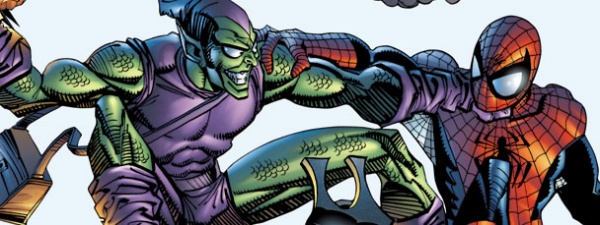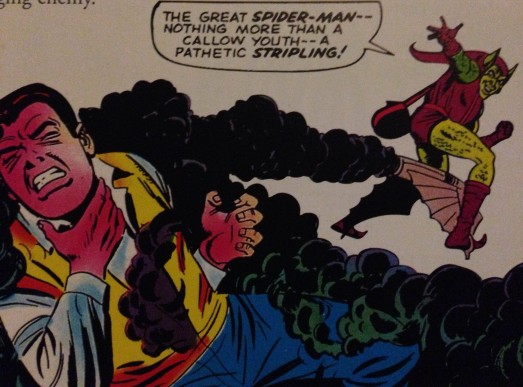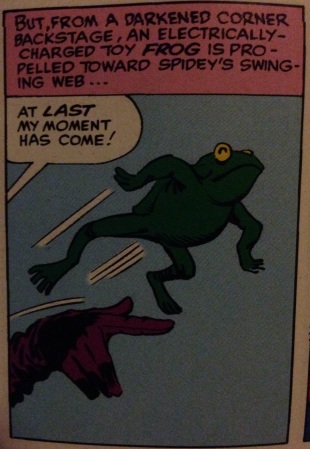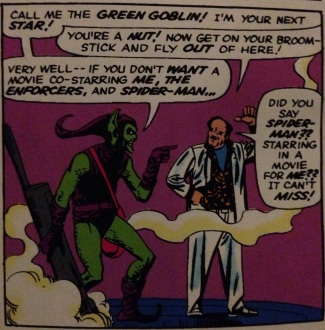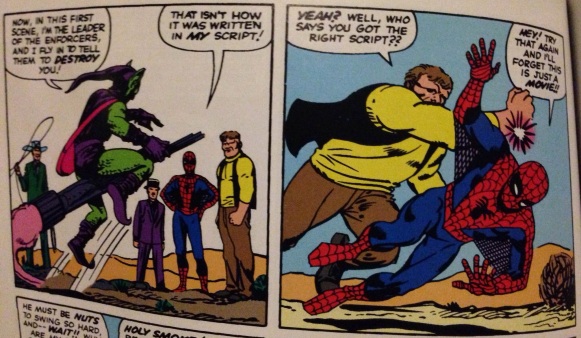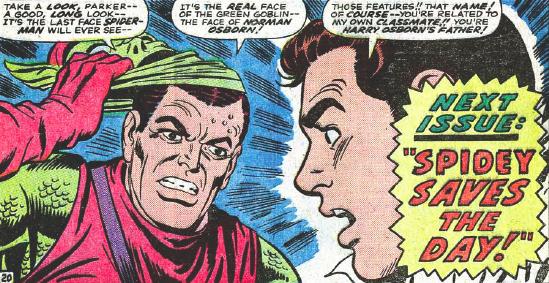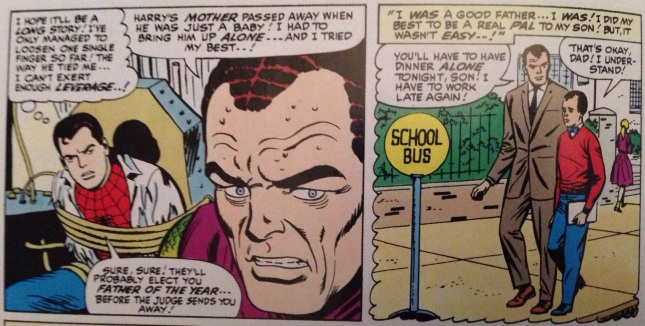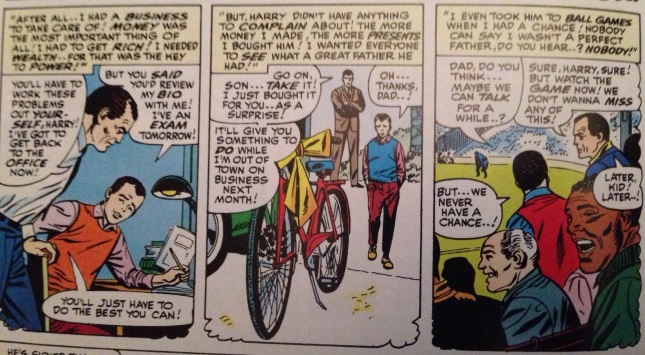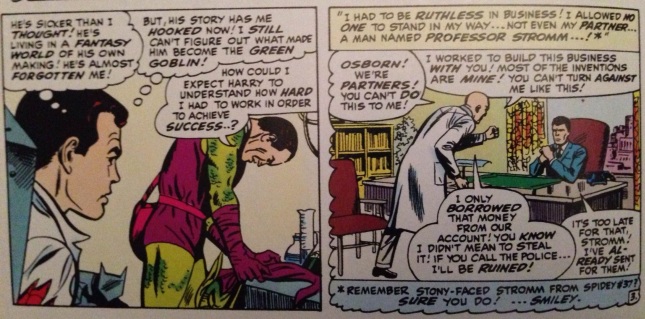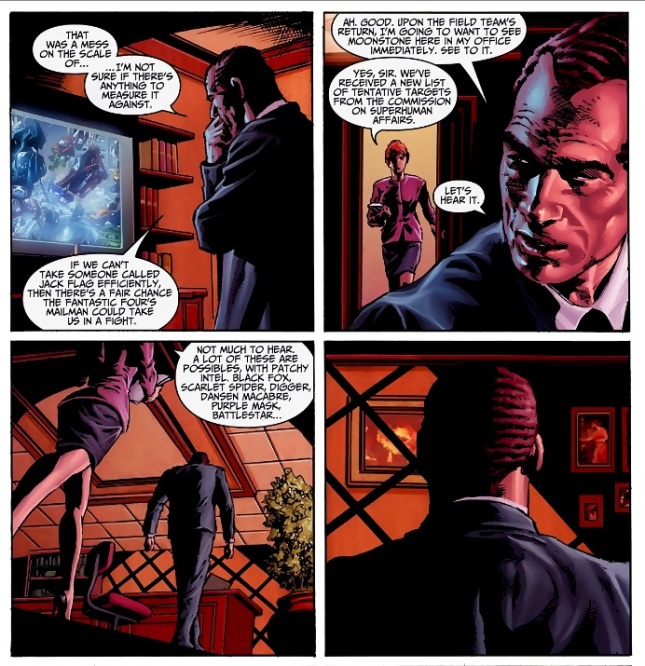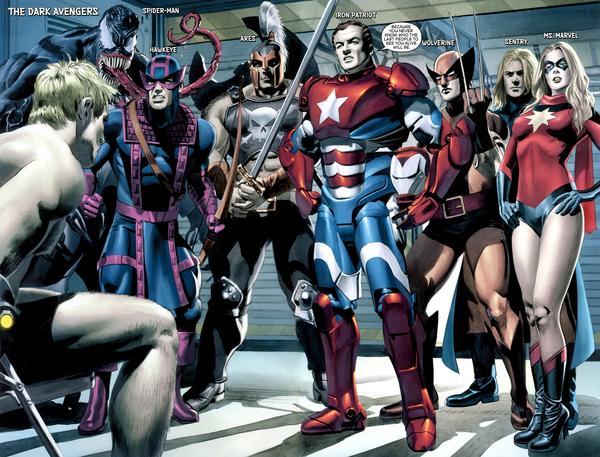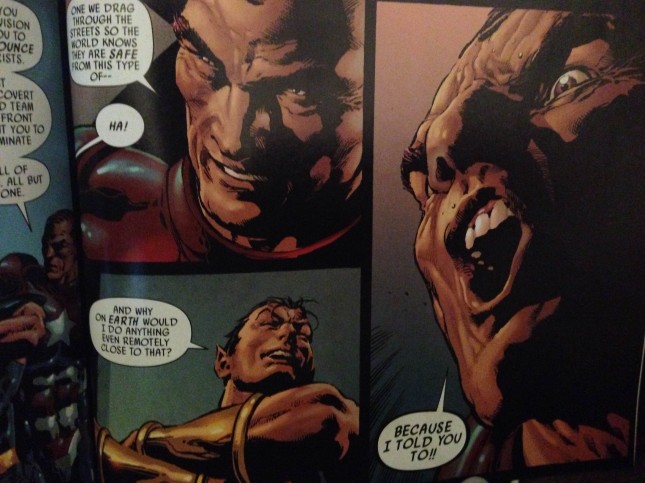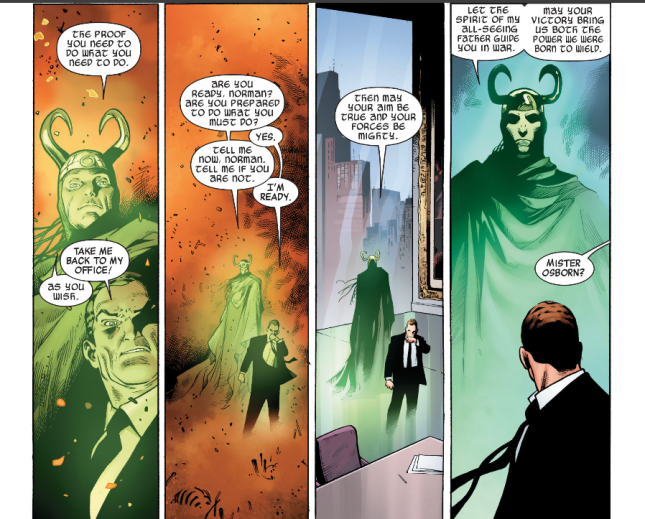DISCLAIMER: Reading, summarizing and examining every appearance of Norman Osborn would be both overly time-consuming and messy. As such, this post will focus on his most significant early appearances and a large part of his recent storylines.
One of the reasons the Spider-Man franchise has lasted so long is due to how personal the character’s world is. Peter Parker is a human being before he’s a superhero, with all of his conflicts having human consequences. Parker isn’t a representative of anything lofty, he’s just a kid in a suit trying his best to help people. With that in mind, what kind of asshole would go out of his way to pick on the poor guy?
Amazing Spider-Man #39 (1966)
Green Goblin/Norman Osborn is one of the oddest comic villains in terms of initial concept. He’s a green skinned (or is it garbed?) man with a purple Legend of Zelda tunic, a flying bat-thing (which was originally a fucking broomstick) who threw exploding pumpkins. And frogs for some reason.
Amazing Spider-Man #17 (1964)
Even his original introduction is wacky as hell: seeking to take over the underworld of NY, Goblin hires three previous Spidey villains named the Enforcers, who consisted of a guy with lasso, a midget karate master, and a “strong for a normal guy” guy. His plan? Approach a film producer and casually suggest to him that he should fund a Spider-Man film. He does this in full costume.
Amazing Spider-Man #14 (1964)
The guy agrees and just stands on a roof top waiting for Spider Man to just happen upon him (which actually works) He pitches him the film, which Spidey agrees to quite easily. The Goblin, having apparently written an honest to god script, has them shoot the first scene in a cave, where his “master plan” this whole time was to just to have himself and the gang (who Spidey thought were just guys who just happened to look like enemies of his) beat him up.
Even as a 60’s comic lover, this debut has to be one of the dumbest i’ve ever read. We don’t even get a passing explanation of the Goblin’s powers, weapons, or even who the fuck he is in the first place. Apparently, writer Stan Lee and artist Steve Ditko disagreed on who the Goblin should be. Ditko felt he should remain anonymous whereas Lee felt he should be someone close to Peter. When Ditko left the series, Lee had his way with the Goblin (that sounds dirty!), which leads us to the revelation that he’s Norman Osborn, father of Peter’s then-new friend, Harry Osborn.
Amazing Spider-Man #39 (1966)
The backstory: Normie had a routine freak lab accident while working on (of course) green chemicals, which increased his mental and physical capabilities. It also increased his crazy as well, which manifested as the character of Green Goblin. Which doesn’t explain the gimmick AT ALL, but whaddaya gonna do? Much later on it was retconned that Norman Osborn had a recurring childhood nightmare of a literal “green goblin” that inspired his motif. So he’s basically an even more fucked up Batman.
The revelation of Norman Osborn as the Goblin is where he goes from being a silly Joker-esque madman to being a truly unique character. Like many villains, Osborn attempts to explain to Peter his origin, but what makes this moment particularly unique is that there’s a clear disconnect between how he views himself as Norman Osborn and the reality of his actions even before he became the Goblin.
Amazing Spider-Man #40 (1966)
In his mind, he was a great father to Harry, whereas we can clearly see he was emotionally distant. In his mind, he’s a pragmatic businessman, whereas we can clearly see he’s quite corrupt. Osborn is completely delusional about his own villainy, a rare trait in comic villains. At this point, most super-villains are just crooks and despots, but he actually thinks his actions are for the best. By the end of this issue, Norman conveniently gets amnesia but this characterization sticks with the character for awhile anyway. His delusion reaches it’s zenith when blames Peter (without cause, of course) for his son’s drug abuse.
Slipping back into his Goblin persona, his method of “justice” is killing Peter’s girlfriend at the time Gwen Stacy. Your welcome for the spoiler.
Amazing Spider-Man #121 (1973)
This sets off a chain of events that leads to his own (of course temporary) death.
Such a heinous act not only codified Osborn’s delusion, but also his pettiness. In a way, this is why he makes such a good antagonist for Spidey. Characters like Superman and Captain America represent lofty ideals, so their antagonists have to be equally as lofty. Generally, Lex Luthor is portrayed as having a sense of purpose so grand that he could just as easily be as heroic as he is villainous. In a Silver Age story, this was realized when he found his own planet (which he un-egotistically dubbed “Lexor”) where he got to play hero.
Superman #164 (1963)
Far from heroic, Osborn’s goals are no more lofty than fucking with Peter. His reintroduction to the Spider-Man franchise was orchestrating an elaborate plot to create clones of Spider-Man and Gwen Stacy just to fuck with him for…ABSOLUTELY NOTHING. Once again, Spidey didn’t do anything to him or Harry before his resurrection and even spared his life after killing Gwen.
Osborn went on to plague Spidey in a number of ways after his resurrection. For example, one story reveals he raised two Spidey-hating kids who he had with Gwen Stacy before her death. Comics, lol. The character continued to be singularly a Spidey villain till the Thunderbolts series, where he led a team of villains who were tasked with policing superheroes. The series illustrates the distinction between Norman’s personalities. Norman is a mixture of Lex Luthor and the Joker. As a businessman and leader, he’s very Luthor-like, with a massive sense of importance and superiority. Then there’s the Goblin persona, which is more Joker-like with an obsession with Spidey and massive bloodlust.
Thunderbolts #111 (2006)
His growing positive reputation combined with a strange set of events allow Norman to become Earth’s greatest hero when he defeats an alien queen during an invasion. His newfound admiration not only allows him to finally rewrite public record of his past crimes, it also means that he’s able to take the role of both Nick Fury AND Iron Man as director of S.H.I.E.L.D. (which he aggressively re- dubs H.A.M.M.E.R.) and leader of the Avengers (having jacked himself some sweet-ass armor and recast the team with equivalent super villains).
New Avengers Annual #3 (2009)
This is definitely his “Lexor” moment, where Stan Lee’s Norman Osborn really comes to fruition. As mentioned, the two defining attributes of Norman are a) delusion b) pettiness. So seeing him in a role where he has to deal with characters like Dr. Doom and Namor, men with both a clarity and grandeur of vision, allows for both humor and tension.
Dark Avengers #6 (2009)
He becomes, dare I say it, almost sympathetic. Osborn is so out of his depth and he knows it. Ironically, he becomes an almost Peter Parker like figure in the larger Marvel Universe. Spidey has also been in the big-time as an Avenger for over a decade now, but he’s often still written as the low man on the totem pole. Spidey’s role on the team is essentially comic relief. Parker and Osborn are both people of just enough ability to reach the peak of Olympus but with the barely the strength to survive the climate once they get there.
Brian Michael Bendis uses the persona of Norman to seemingly comment on the irrationality of real life government leaders (most likely George W. Bush). Norman becomes increasingly obsessed with ” protecting America ” and letting his presence be known. When Asgard ends up hovering near Earth (don’t ask) he immediately views it as a threat despite the fact that NOTHING suggests that at all. As he did with Spidey, Norman delusions created a threat. In order to legitimize Asgard as a threat, he tricks an Asgardian into committing mass murder.
Siege: The Cabal #1 (2010)
Norman’s war with Asgard is most likely meant to reflect the War on Terror, where many feel the American government purposely caused fear of Iraq in order to justify war, some even going as far to claim that 9/11 was engineered by them. Using Norman as a stand-in for Bush is a stretch, but fits into the public perception of what people considered “evil” at the time. Like the ‘corrupt corporate executive’ version of Lex Luthor in the 80’s, Norman reflected America’s distrust of those in power.
Despite losing his war with Asgard and his public clout, Norman continues to be a major villain in Marvel Comics. Norman Osborn/Green Goblin’s continued prominence is a testament to the ability of skilled writers to reinterpret characters. Lets hope the wacko always has a place at Marvel.
For more posts on Spider-Man
The Amazing Spider-Man 2 Review
Spidey Tackles The Torch: Spider-Man As An Anti-Hero
From Amazing Fantasy to Amazing Spider-Man: The Journey of Peter Parker
For more posts on Marvel Comics
Captain America: The Winter Soldier Review
